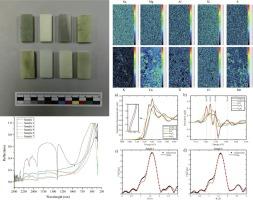从元素绘图到结构洞察:对不同产地软玉的多技术研究。
IF 4.3
2区 化学
Q1 SPECTROSCOPY
Spectrochimica Acta Part A: Molecular and Biomolecular Spectroscopy
Pub Date : 2024-10-19
DOI:10.1016/j.saa.2024.125304
引用次数: 0
摘要
软玉是中国玉文化中一种具有重要历史意义的材料,由于成矿环境不同,其元素组成和光谱特性也因产地而异。本研究旨在解决传统方法的局限性,采用多种技术方法,结合 XRF 图谱、光纤反射光谱(FORS)、近红外光谱(NIR)和同步辐射 X 射线吸收精细结构(XAFS)分析,重点对铁进行全面表征,以了解不同产地软玉的特性。我们的研究结果表明,虽然硅、镁和钙等主要元素分布均匀,但钾、锰和铁等元素的变化很大,其中铁和锰的分布模式几乎完全相同。青海软玉的透明度变化与钙的分布相关。色度分析表明,铁在很大程度上影响了软玉的黄色,而近红外光谱分析则表明,铁的含量会影响光谱特征。XAFS 分析详细揭示了铁的价态和配位环境,突出了铁在颜色变化和光谱偏移中的作用。这种综合方法弥合了元素组成和分布、结构特性和视觉表现之间的相关性,其非破坏性优势可为玉石研究带来巨大前景。本文章由计算机程序翻译,如有差异,请以英文原文为准。

From elemental mapping to structural insights: A multi-technique investigation into the nephrite from various provenances
Nephrite, a historically significant material in Chinese jade culture, varies in elemental composition and spectroscopic properties based on its geographic origin due to differing mineralization environments. This study aims to address the limitations of traditional methods by employing a multi-technique approach that combines XRF mapping, fiber optic reflectance spectroscopy (FORS), near-infrared spectroscopy (NIR), and synchrotron-based X-ray absorption fine structure (XAFS) analysis, focusing on a comprehensive characterization of Fe to understand the properties of nephrite from various provenances. Our results reveal that while major elements like Si, Mg, and Ca are uniformly distributed, elements such as K, Mn, and Fe show significant variability, with Fe and Mn exhibiting nearly identical distribution patterns. Transparency variations in Qinghai nephrite correlate with Ca distribution. Chromaticity analysis indicates that Fe significantly influences the yellow coloration of nephrite, and NIR spectroscopy shows that Fe content affects spectral characteristics. XAFS analysis provides detailed insights into the valence and coordination environment of Fe, highlighting its role in color variation and spectral shifts. This integrated approach bridges the correlation between elemental composition and distribution, structural properties and visual representation, and its non-destructive advantages could hold great promise for jade research.
求助全文
通过发布文献求助,成功后即可免费获取论文全文。
去求助
来源期刊
CiteScore
8.40
自引率
11.40%
发文量
1364
审稿时长
40 days
期刊介绍:
Spectrochimica Acta, Part A: Molecular and Biomolecular Spectroscopy (SAA) is an interdisciplinary journal which spans from basic to applied aspects of optical spectroscopy in chemistry, medicine, biology, and materials science.
The journal publishes original scientific papers that feature high-quality spectroscopic data and analysis. From the broad range of optical spectroscopies, the emphasis is on electronic, vibrational or rotational spectra of molecules, rather than on spectroscopy based on magnetic moments.
Criteria for publication in SAA are novelty, uniqueness, and outstanding quality. Routine applications of spectroscopic techniques and computational methods are not appropriate.
Topics of particular interest of Spectrochimica Acta Part A include, but are not limited to:
Spectroscopy and dynamics of bioanalytical, biomedical, environmental, and atmospheric sciences,
Novel experimental techniques or instrumentation for molecular spectroscopy,
Novel theoretical and computational methods,
Novel applications in photochemistry and photobiology,
Novel interpretational approaches as well as advances in data analysis based on electronic or vibrational spectroscopy.

 求助内容:
求助内容: 应助结果提醒方式:
应助结果提醒方式:


